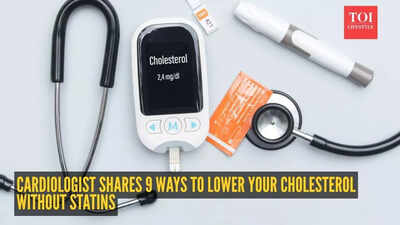ARTICLE AD BOX

Somewhere along the way, high cholesterol stopped sounding like a problem and started sounding like a given, one more number everyone expects to go up with age. Maybe that’s why statins, the go-to drug for lowering it, have become the best-selling prescription in the US, taken by nearly 30 million people each year.
But cholesterol itself was never the villain. It’s a fat our bodies rely on, to build cells, make vitamin D, and produce hormones like oestrogen and testosterone. The danger lies in imbalance: when LDL, the so-called “bad” cholesterol, begins to outpace HDL, the “good” one that helps clear it from our arteries. Those invisible buildups quietly narrow blood vessels, setting the stage for heart disease and stroke long before symptoms appear.
According to NHS guidelines, total cholesterol should stay below 5 mmol/L, with healthy HDL levels above 1.0 for men and 1.2 for women. Still, medication isn’t the only route.
6 daily habits to naturally lower cholesterol levels
Dr Ali Khavandi, a consultant interventional cardiologist at Sulis Hospital, tells The Telegraph, “In the modern world though, high cholesterol is most commonly lifestyle-related and you can smash that through dietary and lifestyle changes.”
Below are nine changes Dr Khavandi highlights that can help you lower your cholesterol without help of statins
Eat good fats, rather than ‘low fat’
Cutting saturated fat (butter, processed meats, pies, cookies) is still key, but replacing it with single-ingredient, unsaturated foods makes the difference. Think oily fish, nuts, seeds, olives and avocados rather than heavily processed “low-fat” products. Study published in The New England Journal of Medicine show that diets enriched with extra-virgin olive oil or mixed nuts lower cardiovascular risk compared with low-fat advice, supporting the idea that swapping to quality fats improves heart outcomes.
A daily glass of tomato juice
Some studies show that a tomato-heavy diet can lower LDL and help raise HDL, likely because lycopene, the tomato’s dominant antioxidant, binds to LDL and helps prevent its oxidation. In one study published in Food science and Nutrition, participants who had unlimited access to unsalted tomato juice saw significant drops in LDL and blood pressure; other short trials have found that even days or weeks of concentrated tomato juice can measurably change lipid markers. Drinking a glass of unsalted or freshly made tomato juice (or using tinned tomatoes in cooking) is an easy way to boost lycopene intake.
Have porridge for breakfast
Oats contain beta-glucan, a viscous soluble fibre that forms a gel in the gut and binds cholesterol, reducing how much is absorbed into the bloodstream. Study published in British Journal of Nutrition showed consistent LDL reductions with oat β-glucan, adding oats to your morning can lower LDL in a matter of weeks.
Get your plant sterols naturally
“Plant sterols and stanols are molecules that are similar in size and shape to cholesterol, so they almost ‘compete’ with it,” says Dr Khavandi. When we eat them and they are absorbed from the intestine into the blood, they will be preventing some of the cholesterol from being absorbed instead. Broccoli, cauliflower and avocado are all rich in sterols, while stanols are found in peanuts, almonds and sunflower seeds.
Don’t base meals around starchy carbohydrates like pasta, sugary cereal, baked potatoes and white bread. Refined carbs can spike blood sugar and raise LDL and triglycerides; swapping in pulses, beans, chickpeas, lentils, gives you low-saturated-fat meals that are high in fibre, especially soluble fibre that traps cholesterol and helps eliminate it.
Skip the snacks (or choose nuts)
Evidence is mixed but promising: time-restricted eating (for example, eating within a 10-hour window consistently) has been associated with reductions in LDL and triglycerides in some studies, and a large umbrella review found intermittent fasting can lower waist circumference, LDL and triglycerides across multiple trials. If you can’t give up snacking, replacing crisps and sweets with whole nuts, almonds, for example, has been shown in randomized trials to lower LDL and improve vascular function.
Studies show alcohol raises fasting and postprandial triglycerides and, in heavier drinkers, increases LDL and total cholesterol; even moderate drinking raises triglycerides for many people. If you’re trying to lower lipids, cutting back on daily alcohol is one of the faster, measurable changes you can make.
Switch butter for extra-virgin olive oil
The monounsaturated fats in olive oil help lower LDL and raise HDL, and the oil’s antioxidants and anti-inflammatory compounds protect arteries from plaque build-up and help lower cholesterol.Note: The information provided in this article is for educational purposes only and is not intended as medical advice. Always consult with a qualified healthcare professional before starting any new medication or treatment and before changing your diet or supplement regimen.

 1 hour ago
6
1 hour ago
6








 English (US) ·
English (US) ·